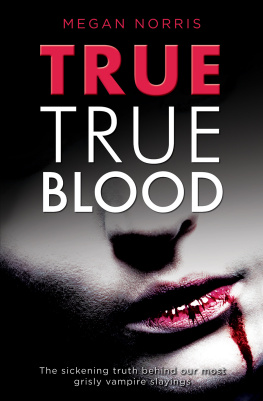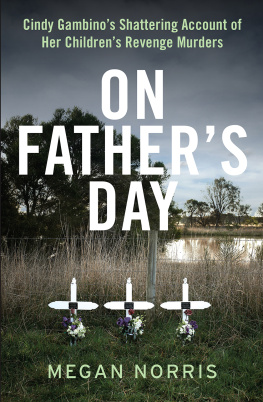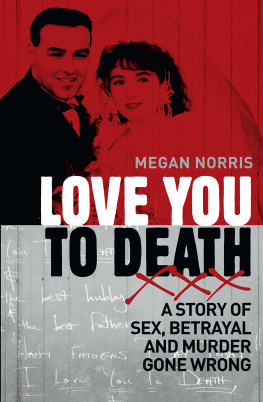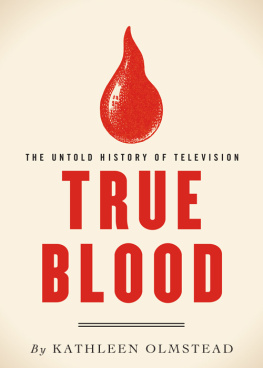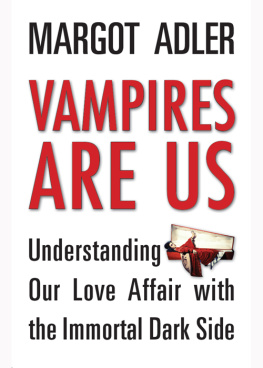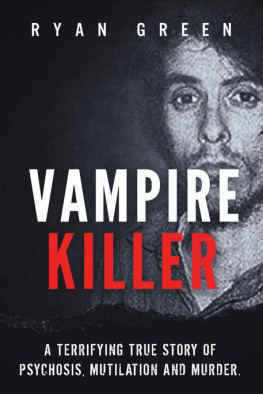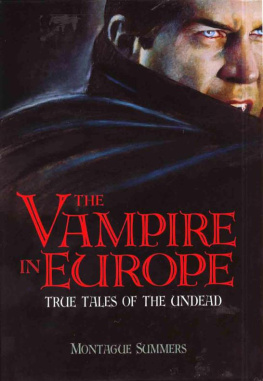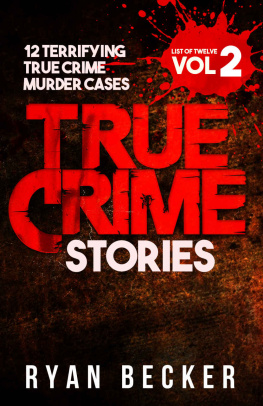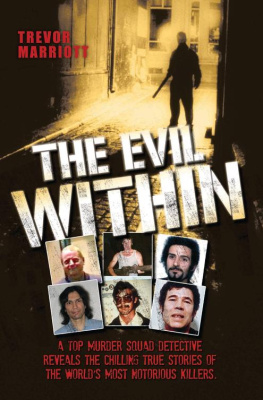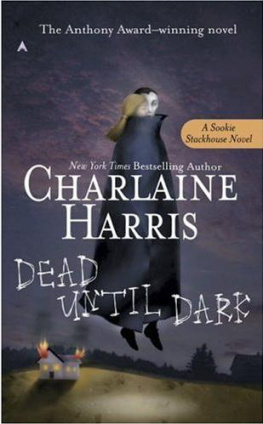True True Blood
The Sickening Truth Behind Our Most Grisly Vampire Slayings
Megan Norris
This book is for Poppy Grijalbo whose passion and enthusiasm for a magazine article I wrote on the subject of vampire killers was the inspiration behind this gory book. Thanks, Poppy.
Acknowledgments
My thanks to my long-suffering husband Stephen for all the hours he spent watching me obsessively researching and writing, and who struggled to share my enthusiasm for the grisly subject matter I unearthed from the dark side.
Thanks also to Five Miles Commissioning Editor Julia Taylor and to John OBrien the National Sales Manager, who fell in love with this book from the gruesome blurb I wrote to tease him with. And a particularly big thank you to Kirstie Innes-Will, my fabulous editor, whose eagle eye and invaluable help has turned this macabre manuscript into an even more chilling read.
These vampire corpses who went out of their graves at night, to suck the blood of the living, either at their throats or stomachs, after which they returned to their cemeteries. The person so sucked waned, grew pale and fell into consumption while the sucking corpses grew fat, got rosy and enjoyed an excellent appetite!
Voltaire
Penned at the height of the eighteenth century vampire frenzy in Europe during which thousands of cadavers were exhumed and staked to stop them stalking the living.
Introduction
Vampires Myths or Monsters?
A young damsel in distress enlists the help of a former sweetheart, now a seductive 500-year-old vampire rebel leader, to help her flee from her supposedly tyrannical parents. The bloodsucking predator slaughters the parents, escaping into the shadows with his hapless charge and leaves behind the grisly signature of his vampire clan, burned into her fathers corpse. Elsewhere, a bloodthirsty Gothic princess roams in a pack by moonlight, hunting for a stranger to sink her fangs into to satisfy her insatiable need to feed. A sadistic black prince begins to stalk the dark side looking for his very own Draculas bride. The lovebirds later seal their depraved union with the sickening ritualistic slaughter of a friend, drinking his blood and making passionate love in a coffin beside the still warm corpse. The creepy sirens ruby red lips, fresh with her victims blood, curl garishly into a smile baring sharpened fangs. A lingering kiss cements their chilling pact with the devil, whose calling card has been carved onto their dead friends chest.
If these macabre tales sound as if they belong in the pages of a fictional bestseller or in the script of a late night horror movie, think again. For contrary to common belief, vampires really do exist outside Transylvania. Horror stories from history reveal that vampires have existed in ancient cultures around the world since civilisation began: almost every culture in the world describes some sort of vampire-like beings that suck the life out of their chosen prey to satisfy their insatiable thirst for blood. Evil comes in many different guises, particularly when it comes to the demons of mythological fantasy and dark folklore. But there is little doubt that the vampire is considered the most evil.
While the roots of vampirism hark back to a climate of superstition and fear, the lingering morbid fascination with vampires lives on today. Dark subcultures associated with vampirism share the same links with the occult, Satanism and black magic as they did in ancient folklore and myth.
Todays obsession with vampires appears to have sparked a flourishing subculture fascinated with these bloodthirsty nocturnal predators who stalk the night. But the vampires of ancient times were viewed in a very different vein to the erotic and glamorous bloodsuckers portrayed in the Twilight movies or television shows such as The Vampire Diaries or True Blood . Yet there are some chilling similarities between the after-dark antics of these screen vampires and the activities of the alleged demons who sparked the vampire frenzy that gripped Eastern Europe during the eighteenth and nineteenth centuries. Vampires were reviled and feared for all the same reasons then that todays modern society recoils from the sickening crimes of contemporary vampire killers.
Back in an era when ancient peoples had not yet coined terms for vampires, many cultures nonetheless lived in abject fear of those beings who took their revenge on the living by drinking their blood and feasting on their flesh. This nocturnal figure was interpreted differently in different cultures. But if its name and form varied from the Eskimos to the Aztecs, from Africa and India to the Americas, beings with an unquestionable thirst for human blood were known of all over the world.
The Persians appear to be one of the first civilisations to have acknowledged the practice of vampirism. Chilling etchings depicting ghastly blood-drinking rituals have been found on pottery unearthed from Persian archaeological digs.
Although we are now most familiar with the vampire as a sophisticated, alluring, caped antihero (a legacy of Bram Stokers blueprint: the smooth-talking, canny Dracula), in ancient myth it wasnt the elusive lone male bloodsucker who most drove fear into peoples hearts. The most feared and reviled of all the bloodthirsty predators that inhabited the dark chapters of grisly folklore and myth were actually female!
In Babylonian and Assyrian myth, a female bloodsucker called Lilitu was believed to exist on the blood of babies. Her counterpart in Hebrew folklore, Lilith, also drank the blood of newborns. Lilith was said to be Adams first wife, who dumped him for his sexual shortcomings and went on to become Queen of the Devils. According to the anonymous medieval Hebrew text Alphabet of Ben Sira, Lilith a name that derives from the Hebrew word layil meaning night was created at the same time as God created Adam and from the same earth. According to folklore, Lilith purportedly dumped Adam for his sexual shortcomings, though the 13th century writings of Rabbi Isaac ben Jacob ha-Cohen, state more simply that she left him because she refused to be subservient. After mating with the Archangel Samael, Lilith refused to return to the Garden of Eden and went on to become Queen of the Demons. God then created Eve from Adams rib, though earths first father didnt have much better luck with his new wife either, who soon succumbed to the temptation of smooth-talking Satan. Lilith is mentioned in the Dead Sea Scrolls Songs of the Sage amongst a list of monsters, though Jewish inscriptions found on bowls and amulets from the 6th century describe her as a demon, and resulting legends still commonly identify her in Western culture with the occult and fantasy.
In Ancient Greek myth, the Estries were a collection of evil female bloodsuckers, believed to have been spawned during the twilight hours while God took a hard-earned break from creating man. These bloodthirsty vampire harpies roamed the world seeking fresh blood from new victims in order to survive. The strong link between vampirism and the occult is thought to have stemmed from these grim horror tales, in which witch-like harpies used black magickal powers to morph into other forms so they could attack their sleeping human prey, usually after dark.
Also in Greek mythology, Empusae, the daughter of the goddess Hecate, was a devil-like crow with bronzed feet, who by night transformed herself into a beautiful young seductress, gorging on the warm blood of men she had seduced. Meanwhile, a similar Roman demon called the Lamae, had a preference for the blood of sleeping children.

